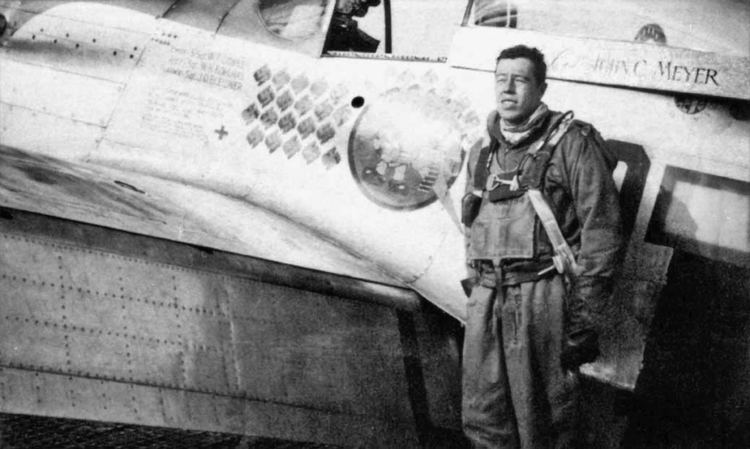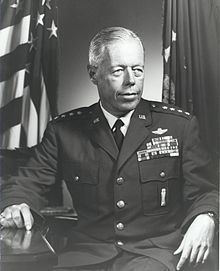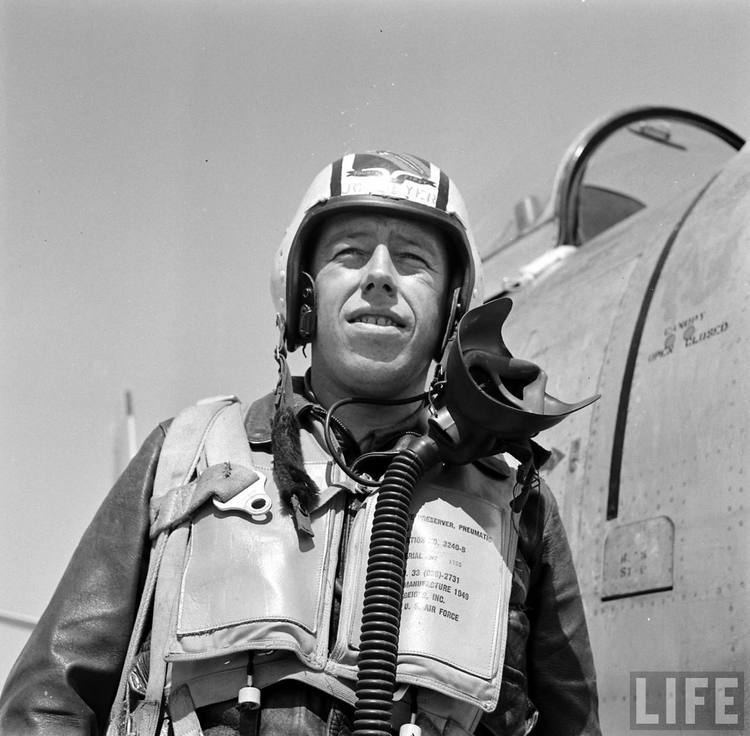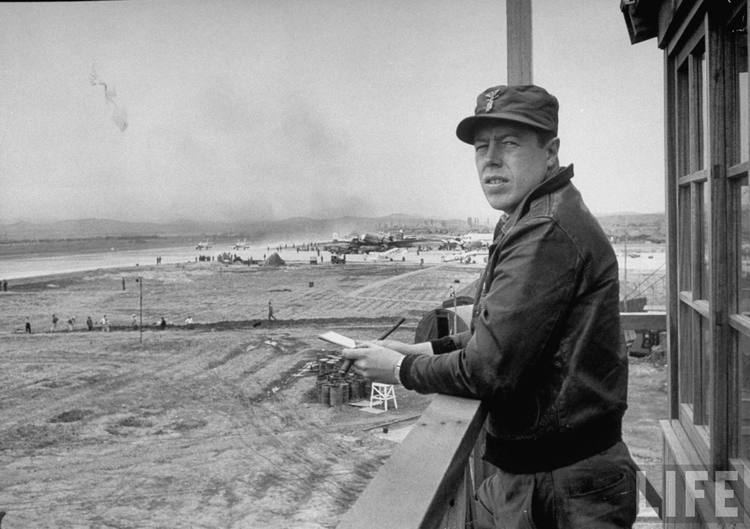Allegiance United States Name John Meyer | Years of service 1939–1974 | |
 | ||
Battles/wars World War IIKorean War Awards Distinguished Service Cross (3)Silver Star (2)Legion of MeritDistinguished Flying Cross (7)Air Medal (15) Died December 2, 1975, Los Angeles, California, United States People also search for Arthur W. Radford, Edward A. Craig, Joseph Stalin Commands held | ||
General John Charles Meyer (April 3, 1919 – December 2, 1975) was an American World War II flying ace, and later the commander-in-chief of the Strategic Air Command (SAC) and director of the Joint Strategic Target Planning Staff at Offutt Air Force Base, Nebraska. SAC was the United States' major nuclear deterrent force with bombers, tankers, and reconnaissance aircraft, as well as intercontinental ballistic missiles. The Joint Strategic Target Planning Staff coordinated the nation's nuclear war plans and developed the Single Integrated Operations Plan.
Contents
- Early life
- Military Career
- World War II
- Postwar assignments
- Korean War
- Later life
- Awards and decorations
- References

Early life

Meyer was born in Brooklyn, New York, on April 3, 1919. He attended schools in New York and left Dartmouth to become an Aviation Cadet in 1939. After World War II, he graduated from Dartmouth College with a bachelor of arts degree in political geography.
Military Career

Meyer enlisted in the United States Army Air Corps in November 1939 in order to become a pilot. In July 1940 he was commissioned a second lieutenant and awarded pilot wings. Second Lieutenant Meyer was assigned to flight instructor duty at Randolph Field, Texas and Gunter Field, Alabama. He was then transferred to the 33rd Pursuit Squadron of the 8th Pursuit Group at Mitchel Field, New York to fly the Curtiss P-40. During the tense days before the United States entered World War II, the Group was sent to Iceland, flying convoy patrol missions.
World War II

In September 1942 he was assigned to the newly formed 352nd Fighter Group at Westover, Massachusetts where he, as a 1st Lieutenant, assumed command of the 34th Pursuit Squadron that had recently returned from the Philippines in name only and was in need of new equipment and personnel. By the end of December, Meyer had received most of the ground personnel and had twenty six pilots assigned, but had no aircraft. In January, the unit moved to New Haven, Connecticut and began picking up the first Republic P-47 Thunderbolt fighters that it would take to combat. The 34th was redesignated as the 487th Fighter Squadron in May 1943 prior to receiving orders to deploy to England.

Captain Meyer took the 487th Fighter Squadron to its new base at RAF Bodney in East Anglia and into combat, scoring its first victory in November. By then he had been promoted to major and began leading the group in aerial victories. He continued to score against German fighters and remain a leading ace after the 352nd transitioned to the North American P-51 Mustang and adopted their famous "Blue Noses". By November 1944 he was deputy commander of the 352nd Fighter Group and the fourth highest scoring American ace in Europe with 24 confirmed air-to-air victories and 13 destroyed on the ground.
In December Meyer, as a Lieutenant Colonel, deployed with the 352nd to a forward base in Belgium designated "Y-29". His foresight in having the 487th squadron preflighted and ready to take off on 1 January averted a major disaster when the field was attacked by fighters of Jagdgeschwader 11 in the massive aerial assault known as Operation Bodenplatte. Meyer led the takeoff under fire and scored against a strafing Focke-Wulf Fw 190 before his landing gear retracted earning a Distinguished Service Cross that day.
Later, a vehicle accident left him with a severe leg injury thereby ending his combat flying with the 352nd after flying 200 combat missions with 462 combat flying hours and scoring 24 aerial victories with another 13 credited to ground strafing.
Postwar assignments
In 1948, Meyer was selected as the Secretary of the Air Force's principal point of contact with the United States House of Representatives.
Korean War
Meyer then returned to a tactical flying unit in August 1950 when he assumed command of the 4th Fighter Wing at New Castle, Delaware. He took the North American F-86 Sabre jet wing to Korea where it flew in the First United Nations Counteroffensive and Chinese Communist Forces Spring Offensive campaigns.
On December 1950, Meyer, led a flight of eight F-86 Sabres against 15 MiG-15s in the first major all-jet fighter battle in history. The flight downed six MiGs without sustaining any losses.
During the war, he destroyed two MiG-15 aircraft, bringing his total of enemy aircraft destroyed (air and ground) in both World War II and Korean War to 39½.
Postwar assignments
After a tour of duty as Director of Operations for Air Defense Command and Continental Air Defense Command, General Meyer graduated from the Air War College, Maxwell Air Force Base, Alabama, in June 1956, and was retained as an instructor at the college. He was then assigned to Strategic Air Command (SAC) where he commanded two air divisions in the Northeast United States. In July 1962 he moved to SAC headquarters at Offutt Air Force Base, as the deputy director of plans, and also served as the commander-in-chief of SAC's representative to the Joint Strategic Target Planning Staff.
In November 1963 General Meyer assumed command of the Tactical Air Command's Twelfth Air Force with headquarters at James Connally AFB in Waco, Texas. Twelfth Air Force provided tactical air units for joint logistic and close air support training with Army ground units stationed in the western half of the United States. In February 1966 he was assigned to the Organization of the United States Joint Chiefs of Staff where he served first as deputy director and then vice director of the Joint Staff. In May 1967 he became the director of operations on the Joint Staff.
Meyer became the vice chief of staff of the United States Air Force in August 1969, remaining in that post through April 1972. On May 1, 1972, he became the seventh commander-in-chief of the Strategic Air Command, and the director of the Joint Strategic Target Planning Staff. As commander of SAC from 1972 to 1974, he directed Operation Linebacker II, the 'Christmas Bombing' of North Vietnam.
General Meyer's military career has included a broad variety of Air Force and joint assignments. He held operational jobs in air defense interceptors, tactical fighters, and strategic bombers. He had also been a key member of the Joint Staff, the Headquarters U.S. Air Force staff, and the Strategic Air Command staff. He had been called upon to command major tactical and strategic units, and retired on July 1, 1974, as commander-in-chief of the Strategic Air Command.
Later life
Meyer died of a heart attack on December 2, 1975 and is buried with full military honors at Arlington National Cemetery.
Awards and decorations
Meyer's military decorations include the Distinguished Service Cross with two oak leaf clusters, Air Force Distinguished Service Medal with oak leaf cluster, Silver Star with oak leaf cluster, Legion of Merit, Distinguished Flying Cross with six oak leaf clusters, Air Medal with 14 oak leaf clusters, and Croix de Guerre with palm from both France and Belgium. In March 1973 be received the Frank Hawks Memorial Award for his many contributions to aviation. He retired July 1, 1974.
Small Arms Expert Marksmanship Ribbon
Croix de Guerre with Palm (France)
Croix de Guerre, with Palm (Belgium)
United Nations Service Medal
